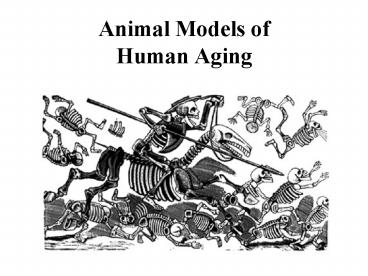Animal Models of Human Aging - PowerPoint PPT Presentation
1 / 11
Title:
Animal Models of Human Aging
Description:
Model should facilitate experimentation. Models allow predictions of ... Slime Mold ('social amoeba') Yeast (Saccharomyces cerevisiae) genome published 1996 ... – PowerPoint PPT presentation
Number of Views:188
Avg rating:3.0/5.0
Title: Animal Models of Human Aging
1
Animal Models of Human Aging
2
- Model- A simple representation of a complicated
subject. - Animal Models of Humans
- Assumption- all life shares many common
processes - eg. DNA, metabolic reactions
- Model should facilitate experimentation
- Models allow predictions of human function
- NIH Biomedical Animal Models Page
3
- Very Simple Unicellular Organisms
- advantage- very rapid generation time
- Bacteria (prokaryotes)
- infinite ability to divide, do not age
- Paramecium, Tetrahymena
- Slime Mold (social amoeba)
- Yeast (Saccharomyces cerevisiae)
- genome published 1996
4
Caenorhabditis elegans A Nematode Worm
5
Microarray Analysis C. elegans
6
Drosophila
7
- Drosophila melanogaster (fruit fly)
- Egg is about half a millimeter long.
- Hatches one day after fertilization (larva).
- Six days after hatching, molts last time
- to form a pupa.
- Over the next four days, adult winged form
hatches. - Fly is reproductively fertile after another day.
- (10-11 Days post fertilization)
- (timing is for 25C
- at 18, development takes twice as long.)
8
Zebrafish, Danio rerio
9
- Advantages of Zebrafish
- Vertebrate (more closely related to human)
- Prolific Breeders
- Transparent Embryos !
- Genetics Well Studied
10
24 hr.
72 hr.
120 hr.
11
Rodent Models
Rats Nutrition and Longevity Studies Transgenic
mice These mice have had a gene or genes
inserted into their DNA and thus have been
genetically engineered. Immunodeficient mice
These have immune deficiencies (one strain is
the nude mouse), they are used to study cancer
among other diseases. Knockout mice These mice
have been engineered to lack specific genes.































